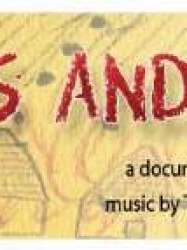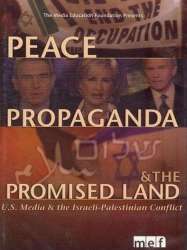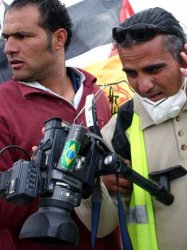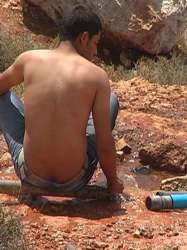Bomb Harvest est un film de genre Documentaire
Bomb Harvest (2007)

Si vous aimez ce film, faites-le savoir !
Durée 1h28
Genres Documentaire
Themes Documentaire sur la guerre, Documentaire historique, Documentaire sur la politique, Politique
Note73%










Bomb Harvest is a 2007 documentary film directed by Australian filmmaker Kim Mordaunt and produced by Sylvia Wilczynski. It explores the consequences of war in Laos as it follows an Australian bomb disposal specialist, training locals in the skill of detonating bombs while trying to stop villagers, particularly children, from finding them and using them for scrap metal.
During the Vietnam War, Laos was the target of the heaviest US bombing campaign, making Laos the most bombed country in history: from 1964 until 1973 more than two million tonnes of bombs were dropped, including 260 million cluster munitions. An estimated 30 per cent of the bombs dropped did not detonate. Unexploded Ordnance (UXO) continues to kill and injure people, and prevent them from using land, including growing food. UXO are a key factor in the poverty and stifling the development of the country.
Bomb Harvest explores how three generations of people have been left to deal with the consequences of the air war, and depicts the bravery of those trying to clear up its remnants.
The film crew spent two months on the ground with bomb disposal teams from the Mines Advisory Group as they dealt with live bombs, in areas of Laos which have never been filmed in before. The film premiered at the 2007 Sydney Film Festival, and won a Children's Advocacy award at the 2008 Artivist Film Festival.
Commentaires
Postez un commentaire :
Suggestions de films similaires à Bomb Harvest
Il y a 8965 ayant les mêmes genres cinématographiques, 8199 films qui ont les mêmes thèmes (dont 243 films qui ont les mêmes 4 thèmes que Bomb Harvest), pour avoir au final 70 suggestions de films similaires.Si vous avez aimé Bomb Harvest, vous aimerez sûrement les films similaires suivants :

Crayons and Paper (2009)
, 30minutesOrigine Etats-Unis
Genres Documentaire
Thèmes Afrique post-coloniale, L'enfance, La mer, Transport, Documentaire sur le droit, Documentaire sur la guerre, Documentaire historique, Documentaire sur une personnalité, Documentaire sur la politique, Politique

Eau argentée (2014)
, 1h50Réalisé par Usama Muhammad
Origine Syrie
Genres Documentaire
Thèmes Film traitant du cinéma, Informatique, Documentaire sur le monde des affaires, Documentaire sur le cinéma, Documentaire sur le droit, Documentaire sur la guerre, Documentaire historique, Documentaire sur la politique, Documentaire sur les technologies, Politique, Documentaire sur les films
Note74%





Le film aborde, par des dizaines de vidéos YouTube amateurs compilées, la guerre civile syrienne. Il narre la destruction et les atrocités commises lors de la guerre, filmées par des téléphones mobiles et postées sur Internet, compilées avec des plans tournés par Wiam Bedirxan pendant le siège de Homs (2011-2014). Le montage a été réalisé en association avec Ossama Mohammed, en exil à Paris, et les deux réalisateurs expriment leurs impressions personnelles.
 , 1h20
, 1h20Origine Etats-Unis
Genres Documentaire
Thèmes Afrique post-coloniale, Religion, Documentaire sur le droit, Documentaire sur la guerre, Documentaire historique, Documentaire sur une personnalité, Documentaire sur la politique, Documentaire sur la religion, Politique, Religion juive
Note81%






Bougafer 33 (2010)
, 52minutesOrigine Maroc
Genres Documentaire
Thèmes Afrique post-coloniale, Documentaire sur le droit, Documentaire sur la guerre, Documentaire historique, Documentaire sur la politique, Politique
Taking the expedition of a group of Frenchmen following in the tracks of their fellow countrymen as a starting point, Bougafer 33 is a journey through time and space that tells of the battle that took place in 1933 at the foot of the Bougafer Mountain during the war Morocco fought against the French-Spanish colonial conquest. Eyewitness accounts, stock footage, written tales and songs all contribute to reinstate the history of the last resistants of the Ait Atta. An epic ordeal of fierce and highly organized battles in which women and children took part in the name of freedom.

5 Caméras Brisées (2011)
, 1h34Origine Israel
Genres Drame, Guerre, Documentaire, Policier
Thèmes Afrique post-coloniale, Film traitant du cinéma, Religion, Documentaire sur le monde des affaires, Documentaire sur le cinéma, Documentaire sur le droit, Documentaire sur la guerre, Documentaire historique, Documentaire sur une personnalité, Documentaire sur la politique, Documentaire sur la religion, Politique, Religion juive, Documentaire sur les films
Note78%





Lorsque son quatrième fils naît en 2005, Emad Burnat, un cameraman palestinien autodidacte, achète sa première caméra. Au même moment, dans son village de Bil'in, une barrière de séparation est construite et les villageois commencent à résister.

Suicide Killers (2006)
, 1h20Réalisé par Pierre Rehov
Origine Etats-Unis
Genres Documentaire
Thèmes Maladie, Le suicide, Le terrorisme, Documentaire sur le droit, Documentaire sur la guerre, Documentaire historique, Documentaire sur une personnalité, Documentaire sur la politique, Documentaire sur la santé, Documentaire sur le terrorisme, Folie, Le handicap, Politique
Note63%





 , 52minutes
, 52minutesOrigine Algerie
Genres Documentaire
Thèmes Afrique post-coloniale, L'immigration, Documentaire sur le droit, Documentaire sur la guerre, Documentaire historique, Documentaire sur une personnalité, Documentaire sur la politique, Politique
En 1939, la fin de la guerre civile espagnole oblige des milliers d’hommes, de femmes et d’enfants à fuir l’Espagne franquiste. En Algérie, l’administration française ouvre des camps pour les accueillir. 70 après, un jeune Algérien enquête sur ces camps. Malgré l’absence d’archives, les traces ont survécu à l’oubli collectif et transparaissent dans l’Algérie d’aujourd’hui.

海と夕陽と彼女の涙 ストロベリーフィールズ (2006)
, 1hOrigine Israel
Genres Drame, Documentaire, Fantasy
Thèmes Afrique post-coloniale, L'environnement, Religion, Documentaire sur le monde des affaires, Documentaire sur le droit, Documentaire sur l'environnement, Documentaire sur la guerre, Documentaire historique, Documentaire sur une personnalité, Documentaire sur la politique, Documentaire sur la religion, Politique, Religion juive
Acteurs Mitsuki Tanimura, Yuria Haga
Strawberry Fields points out that strawberries grown in Gaza are the only agricultural product marketed internationally as being of Palestinian origin. One of the major Gaza strawberry farms in located at Beit Lahiya. More than 1,500 tons of strawberries are exported from Gaza to Europe through the Israeli company Agrexco. In order to get overseas, however, the fruits need to pass through the checkpoint that separates Israel and Gaza. The 2005–2006 growing season coincided with the Israel's disengagement from Gaza and the rise of Hamas as the ruling political entity. The armed conflict between Israel and Hamas resulted in the closing of the border checkpoint. The strawberries grown at Beit Lahiya cannot leave Gaza, resulting in significant losses for the farmers and their Agrexco partners. Unable to transport their produce, the farmers have no choice but to dispose of their crop and prepare for the following year’s growing season.

Le Prince vert (2014)
, 1h41Genres Thriller, Documentaire
Thèmes Afrique post-coloniale, Religion, Documentaire sur le droit, Documentaire sur la guerre, Documentaire historique, Documentaire sur la politique, Documentaire sur la religion, Politique, Religion juive
Note71%





Prince par son ascendance familiale et Vert pour la couleur du drapeau du Hamas, Musab Hassan Yousef est le fils aîné de l'un des chefs de file du Hamas en Cisjordanie. De 1997 à 2007, il sera la meilleure source du renseignement intérieur israélien.

Zramim Ktu'im (2010)
, 1h15Origine Israel
Genres Documentaire
Thèmes Afrique post-coloniale, L'environnement, Religion, Documentaire sur le droit, Documentaire sur l'environnement, Documentaire sur la guerre, Documentaire historique, Documentaire sur une personnalité, Documentaire sur la politique, Documentaire sur la religion, Politique, Religion juive
Paths of lives are crossed in one village in the West Bank. Along the broken water pipelines, villagers walk on their courses towards an indefinite future. Israel that controls the water, supplies only a small amount of water, and when the water streams are not certain nothing can evolve. The control over the water pressure not only dominates every aspect of life but also dominates the spirit. Bil-in, without spring water, is one of the first villages of the West Bank where a modern water infrastructure was set up. Many villagers took it as a sign of progress, others as a source of bitterness. The pipe-water was used to influence the people so they would co-operate with Israel’s intelligence. The rip tore down the village. Returning to the ancient technique of collecting rainwater-using pits could be the villagers’ way to express independence but the relations between people will doubtfully be healed.
 Connexion
Connexion